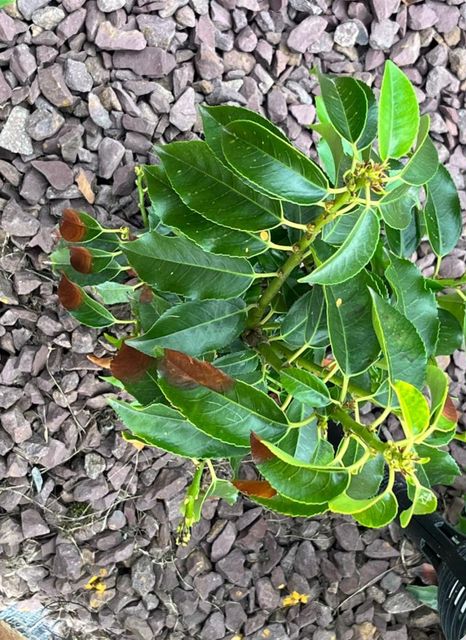Recent stormy weather has begun to denude trees of their beautiful autumnal colours. As the brightly coloured leaves fall and carpet the ground with their golden tapestry, a new treasure becomes more visible. Autumn berries, the maturation of summer blossoms, are quite striking when the branches are bare. On the Sugar Loaf Mountain near where I live, the mountain ashes have shed their yellow leaves but are heavy with clusters of rich red berries. Garden cultivars of this species will vary in the colour of their fruit — some a creamy yellow such as ‘Joseph Rock’ and or a rich cerise such as ‘Pink Pagoda’.
Evergreen trees are also rich with autumn bounty. Holly is a standout specimen and remains the go-to Christmas decoration with its festive red berries and prickly glossy dark foliage. Cotoneaster is also good at this time of year. Cotoneaster ‘Cornubia’ is a large semi-evergreen shrub that is very ornamental with arching branches and lots of heavy clusters of fat red berries. If you are looking for a multi-seasonal interest tree for a small garden, Cotoneaster rothschildianus is an elegant semi-evergreen small tree which has white flowers in summer followed by bunches of delicate light yellow fruits. It’s easy to grow on most soils in sun or partial shade and drought tolerant once established.
The viburnum family has much to offer as well. Look out for the fruit of our native Guelder rose, Viburnum opulus. Often seen in native hedgerows, the berries are small glistening red and almost translucent in appearance. The ubiquitous Viburnum davidii, much loved by landscapers for its ease in sun or shade and a variety of soils, bears clusters of almost metallic-looking blue-black berries.
Aside from the aesthetic appeal of berries, they perform an important role in sustaining birds over the winter. Birdwatch Ireland can pinpoint which species of birds favour different shrubs. For example, blackbirds particularly favour the red and orange Cotoneaster berries, while pyracantha will attract a whole range of species. And it’s not just shrubs but also climbers that can provide sustenance.
Our native ivy makes good cover for nest building and the blackberries that persist through winter are eaten by woodpigeons, thrushes, robins and blackcaps. Grow honeysuckle for its sweetly scented flowers in summer and the subsequent berries will attract warblers, thrushes and bullfinches.
Water is also vital for birds so if you have the option, leave out some fresh water so they can drink and bathe. When it gets cold and water freezes over in the wild, it will be a great help to them. Birds bring great joy and beauty to the garden but they also perform an invaluable function for the gardener as they are a natural predator for snails and slugs — a great reason to support our feathered friends.
Read more
Euonymus europaeus
Plant of the Week
Euonymus europaeus
This is a native shrub with wonderful autumn fruit. Also known as spindleberry, the bright pink berries split to reveal orange seeds. ‘Red Cascade’ is a good garden variety with arching branches and vivid scarlet autumn foliage. Grow in full or partial sun on well-drained moist soil.
Reader Q&A
Q. Can you help me identify what could be causing the brown tips on our Japanese laurel?
The browning leaves of a Japanese laurel
Brown tips or margins often indicate that the shrub hasn’t received enough hydration. This is particularly the case with young growth and it looks like your shrub is quite new. If you planted it this spring and dry weather followed, the shrub may not have established adequate roots to sustain itself. Not to worry, cut the brown bits off if they are bothering you and as the shrub develops, so will its root system and ability to absorb adequate water.
Submit your gardening questions to Diarmuid via his Instagram @diarmuidgavin using the hashtag #weekendgarden

